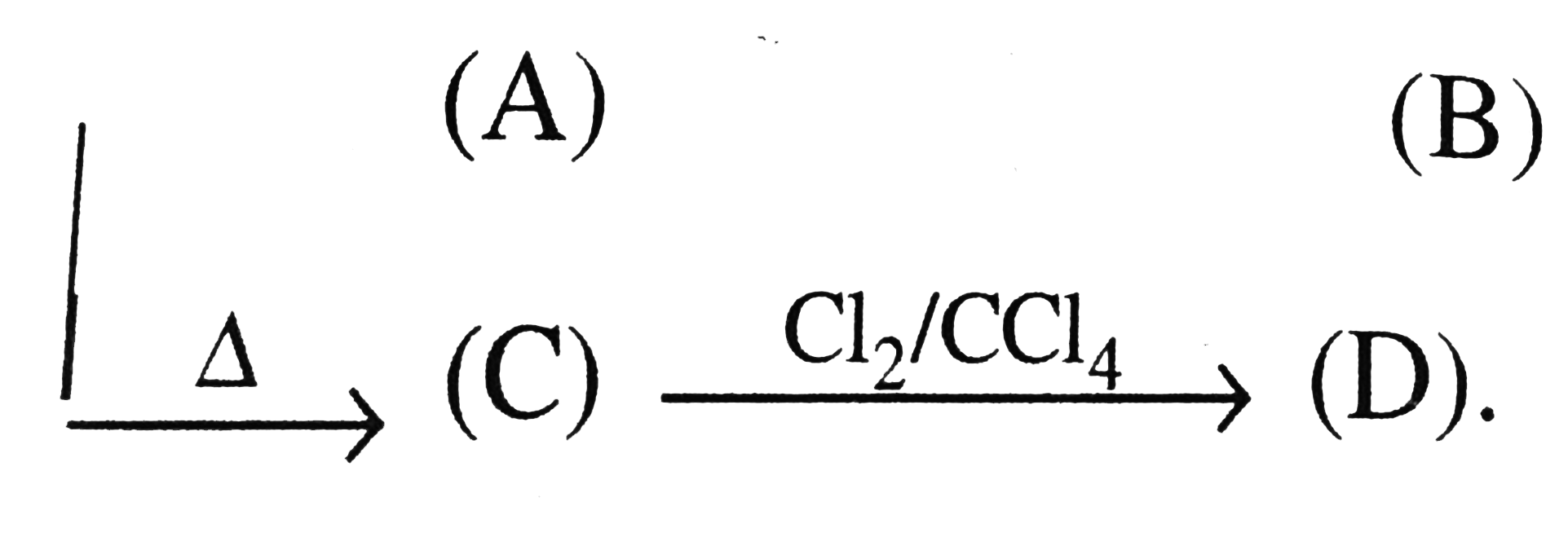Synthesise the following:
i. Propane to a. 1− fluroopropane, b. cyclopropane, and c. 2.3− dunethl butane
ii. 
iii. C2H5Br to but −1− ene
iv. 
v. CYclopetane ro hexachloropentadience
(vi) Cyclopentadiene + Hexachlorocyclopentadiene

i. a. 
b. 
c.  <br> ii. <img alt=)
iii. 
In the reaction from (I) to (II), gendihalide is not formed because Br deactivates (−CHBr)
In the reaction from (III) to (IV) to (IV),H2/Catalyst cannot be used becuase (C−X) will also break to (C−H) bond.

In the conversation of (V) to (VI), H2/catalsyt cannot be used become (C−S) bond will also break to (C−H) bond.
 C.
C.  (VII) has two asymmetric C atoms exists as two reacmates.
(VII) has two asymmetric C atoms exists as two reacmates.
V. 
VI. 
Topper's Solved these Questions
- AROMATIC COMPOUNDS AND ALKYL AND ARYL HALIDES BOOK - CENGAGE CHEMISTRY ENGLISHCHAPTER - AROMATIC COMPOUNDS AND ALKYL AND ARYL HALIDES EXERCISE - Exercises Subjective
17 Videos
- AROMATIC COMPOUNDS AND ALKYL AND ARYL HALIDES BOOK - CENGAGE CHEMISTRY ENGLISHCHAPTER - AROMATIC COMPOUNDS AND ALKYL AND ARYL HALIDES EXERCISE - Exercises Concept Application Type
2 Videos
- AROMATIC COMPOUNDS AND ALKYL AND ARYL HALIDES BOOK - CENGAGE CHEMISTRY ENGLISHCHAPTER - AROMATIC COMPOUNDS AND ALKYL AND ARYL HALIDES EXERCISE - Solved Problems
37 Videos
- APPENDIX INORGANIC VOLUME 2BOOK - CENGAGE CHEMISTRY ENGLISHCHAPTER - APPENDIX INORGANIC VOLUME 2EXERCISE - Short Answer Type
179 Videos
- BIOMOLECULESBOOK - CENGAGE CHEMISTRY ENGLISHCHAPTER - BIOMOLECULESEXERCISE - Exercises Archives (Analytical And Descriptive)
8 Videos
Similar Questions
a. Convert butan−1−ol to 3−chlorobutan −2−ol.
b. Convert propene to:
i.. 1−chloropropane, ii. 2−chloroproopane, iii. 2−methyl pentane, iv. 2,3−dimethyl butane , and v. pentane.
View SolutionConsider the following two reactions:
i. Propene +H2→ Propane, ΔH1
ii. Cyclopropane +H2→ Propane, ΔH2 Then, ΔH2−ΔH1 will be:
View Solution
Knowledge Check
Consider the following two reactions:
i. Propene +H2→ Propane, ΔH1
ii. Cyclopropane +H2→ Propane, ΔH2 Then, ΔH2−ΔH1 will be:A0B2BEC−C−BEC=CCBEC=CD2BEC=C−BEC−CConsider the following two reactions :
(i) Propene +H2→Propane, ΔH1
(ii) Cyclopropane+H2→Propane, ΔH2
Then, ΔH2−ΔH1 will beA(a) 0B(b) 2BEC−C−BEC=CC(c) BE_(C=C)D(d) 2BEC=C−BEC−CConsider the following two reactions :
(i) Propene +H2→Propane, ΔH1
(ii) Cyclopropane+H2→Propane, ΔH2
Then, ΔH2−ΔH1 will beA0B2BEC−C−BEC=CCBEC=CD2BEC=C−BEC−C
Give the order of reactivity towards SN2 reaction of the followig:
a. i. 1− Bromopentane
ii. 2− Bromopenatane
iii. 2− Bromo −2 methyl butane
b. i. n− Butybromide (C4H9Br)
ii. Isobutyl bromide Me2CHCH2Br
iii. sec− Buityl bromnide CH3−CH(Me)CH2Br
iv. tert- Butyl bromide Me2C−Br
View SolutionGive the order of reactivity towards E2 dehydrohalo-genation of the following.
a. i. C2H5Br
ii. C3H7Br
iii. Isobutyl bormide
iv. Neopentyl bromide
b. i. 2− Bromo −2− methybutane
ii. 1− Bromo pentane
iii. 2− Bromo pentane
iv. 3− Bromo pentane
View SolutionWhich of the following is most acidic
(i) Butane (ii) But-1-ene (iii) But-1-yne (iv) But-2-yne ?
View SolutionWhich of the following ligands are of σ -donor and π- acceptor type?
(i) C2H2, (ii) C2H4, (iii) CO, (iv) ¯¯¯CN, (v) (σ−C3H−5)
View SolutionArrange the following compounds in increasing order of boiling point :
Propan-1-ol, butan-1-ol, butan-2-ol, pentan-1-ol
View Solution
